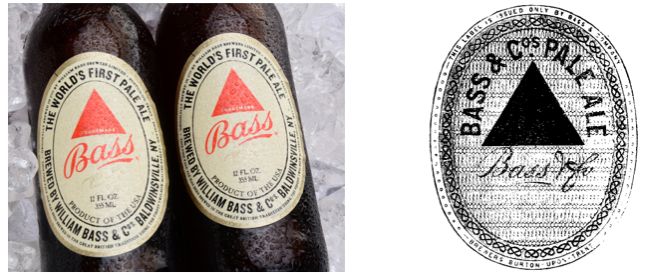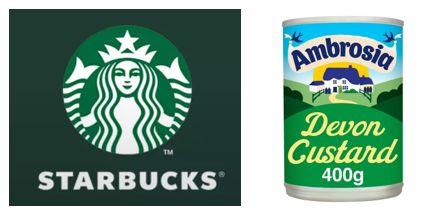In the UK, trade marks and the food and drink industry have a long and rich heritage. One of the most well known of these stories begins in 1876, when the Bass Pale Ale label incorporating the Red Triangle logo became the first trade mark to be registered under the UK's new Trade Marks Registration Act 1875.

BASS Pale Ale Label on the bottle (left); The first trade mark registered under the UK Trade Mark Registration Act 1875 (right)
The story goes that a Bass Brewery employee queued overnight outside the Registrar's office on New Year's Eve 1985 to ensure that they were the first in line to register their trade mark when the act came into force on the 1st January 1876. As a result, the Bass Red Triangle has become a historic case study showcasing the strategic foresight and value to be gained from early brand protection.
For Bass Brewery, the Red Triangle goes beyond being merely a logo – it's a valuable asset, differentiating their products from their competitors and the bedrock for establishing a consistent and reliable brand identity. The trade mark protection for the Red Triangle logo has therefore been pivotal to maintaining that identity for over a hundred years.
In the competitive landscape of the food and drink industry, trade marks play a vital role in safeguarding a brand's identity. They help to protect those distinctive elements that not only visually identify products or services but that also encapsulate a brand's reputation, quality, and heritage.
A trade mark refers to a graphically representable sign, which, amongst other things, can be a brand name, logo, slogan or unique element of the packaging, that essentially serves as a visual cue. Trade marks protect the elements of a brand that distinguishes it's product or services from those of another. Their primary function is to facilitate consumer recognition, fostering repeat purchases and thereby building a brand's reputation for reliability and quality.
To be registrable as a trade mark the sign must be distinctive i.e. capable of functioning as a badge of origin, and cannot be descriptive of the relevant product or service. However, within those criteria these brand elements can fall on a scale from the invented and fanciful marks, such as STARBUCKS®, named after the first mate on the Pequod in Moby-Dick, to the suggestive and allusive, such as AMBROSIA®, which refers back to the food or drink of the gods in Greek mythology.

Trade Mark protection grants exclusive rights to use the protected sign on the applied for goods or services, preventing others from causing confusion by using the same or a similar mark on those same or similar goods or services.
As seen in the Bass Brewery example, trade mark protection can differ from other types of registered intellectual property rights in terms of how long it can exist. A trade mark can be renewed, typically at 10 year intervals for an indefinite period. The only requirement is that it continue to be used in the same or a closely similar format and for the goods/services covered by the trade mark registration, otherwise, it could be cancelled by another party for non-use at any point after the first 5 years following registration. This can be particularly valuable, especially where companies have invested significant amounts in not only creating a distinctive brand, but also in promoting it and building the trust and recognition in it with their consumers.
Crucially, trade mark protection serves both business and consumer interests. For example, seeing the Bass Red Triangle assures consumers of the product's quality and adherence to Bass Brewery's reputation. In a competitive market, trade marks act as shields, preventing competitors from capitalizing on a brand's goodwill. Examples like COCA-COLA® and MCDONALD'S® also demonstrate how instant recognition, facilitated by both marketing and legal efforts, reinforces consumer expectations.

In the food and drink sector, trade marks transcend mere branding, becoming vital tools to distinguish products in a crowded market. The Bass Red Triangle transformed into a symbol of brewing excellence, contributing to Bass's enduring reputation. Its success underscores the potency of consistent brand representation and protection, fostering consumer trust and loyalty.
The exclusivity granted by trade mark law preserves market share and brand integrity. Moreover, trade marks cultivate customer loyalty by associating positive experiences and quality with a brand. This trust is especially crucial in an industry where taste and quality are paramount.
In conclusion, trade marks are the bedrock of protecting brand identity in the dynamic food and drink sector. In an era of abundant consumer choices, trade mark protection is not just a legal necessity but a strategic imperative, ensuring a brand's essence remains a beacon of reliability and trust. These silent guardians guide consumers through a crowded marketplace, preserving brand integrity and individuality, making our culinary experiences memorable. The Bass Red Triangle, with its rich history, exemplifies the lasting impact and importance of trade mark protection—not just a legal asset but a strategic business asset standing the test of time in the world of food and drink.
If you are considering trade mark protection for your brand and brand assets, below are some practical points to consider:
1. Is your brand distinctive and capable of functioning as a trade mark. If there are concerns around this or you are unsure, speak to a Trade Mark Attorney for further advice on your options.
2. Conduct some research to make sure that there isn't already another brand in your area that is the same or similar to the one you are thinking of adopting. Consider consulting with a Trade Mark Attorney for registered trade mark searches to ensure that your proposed name or logo for example, is free for your use and registration.
3. Consider protecting other brand elements and not just the brand name, particularly if these are things that your consumers identify with you or your product.
The content of this article is intended to provide a general guide to the subject matter. Specialist advice should be sought about your specific circumstances.

